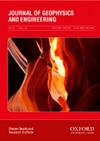基于正则化算法的二维井间电磁反演算法
IF 1.7
3区 地球科学
Q3 GEOCHEMISTRY & GEOPHYSICS
引用次数: 0
摘要
目前处于电测井技术前沿的井间电磁法,从根本上解决了单井测井横向成像能力差、井间物性检测不到位的问题。然而,由于地下储层分布的复杂性和地球物理反演的非唯一性问题,目前还缺乏实用有效的井间电磁反演方法。我们的目标是开发一种有效的方法来减少反演中恢复的物理性质模型的非唯一性。值得注意的是,正则化算法(RA)作为近似求解反演问题的一种手段,可以通过改变正则化函数的形式来获得不同的解,从而保证反演结果的稳定性,符合已知地质或地球物理中的光滑或不光滑特征。我们通过改变正则化中$\alpha$系数的值,并使用Lawson范数作为${l}_p$p\in[{0,2}]$的$norm近似形式。同时,使用迭代重加权最小二乘法求解优化问题,并依次调整高斯-牛顿解中的梯度,以确保正则化中的每一项都有助于最终解。与传统${l}_2$范数反演方法,稀疏反演方法可以更有效地利用已知物理性质的信息,获得更好的反演结果。然后,通过模型试验和某矿区实测数据的反演,验证了反演方法的有效性。本文章由计算机程序翻译,如有差异,请以英文原文为准。
2-D cross-hole electromagnetic inversion algorithms based on regularization algorithms
The cross-hole electromagnetic (EM) method, which is currently at the forefront of electric logging technology, fundamentally solves the problems of the lateral imaging ability of single well logging and the lack of detection of inter-well physical properties. However, due to the complexity of underground reservoir distribution and the non-uniqueness problem of geophysical inversion, there remains a lack of practical and effective cross-hole electromagnetic inversion methods. Our goal is to develop an efficient method to reduce the non-uniqueness of the physical property model recovered in the inversion. It is worth noting that the regularization algorithm (RA), as a means to approximately solve inversion problems, can obtain different solutions by changing the form of the regularization function, so as to ensure the stability of inversion results and conform to the smooth or non-smooth characteristics in known geology or geophysics. We adjust the features of the final inversion model in a defined framework by changing the values of the $\alpha $coefficient in the regularization and using the Lawson norm as a ${l}_p$-norm approximation form for $p \in [ {0,2} ]$. At the same time, the iteratively reweighted least squares method is used to solve the optimization problem, and the gradient in the Gauss-Newton solution is adjusted successively to ensure that every term in the regularization contributes to the final solution. Compared with the traditional ${l}_2$-norm inversion method, the sparse inversion method can make more effective use of information regarding known physical properties and obtain better inversion results. Then, the effectiveness of our inversion method is verified by model tests and inversion of measured data in a mining area.
求助全文
通过发布文献求助,成功后即可免费获取论文全文。
去求助
来源期刊

Journal of Geophysics and Engineering
工程技术-地球化学与地球物理
CiteScore
2.50
自引率
21.40%
发文量
87
审稿时长
4 months
期刊介绍:
Journal of Geophysics and Engineering aims to promote research and developments in geophysics and related areas of engineering. It has a predominantly applied science and engineering focus, but solicits and accepts high-quality contributions in all earth-physics disciplines, including geodynamics, natural and controlled-source seismology, oil, gas and mineral exploration, petrophysics and reservoir geophysics. The journal covers those aspects of engineering that are closely related to geophysics, or on the targets and problems that geophysics addresses. Typically, this is engineering focused on the subsurface, particularly petroleum engineering, rock mechanics, geophysical software engineering, drilling technology, remote sensing, instrumentation and sensor design.
 求助内容:
求助内容: 应助结果提醒方式:
应助结果提醒方式:


